| | Published April 25th, 2012
| Know, Sow, Grow! Heirlooms, Organics, and GE's Digging Deep with Cynthia Brian
| | By Cynthia Brian | 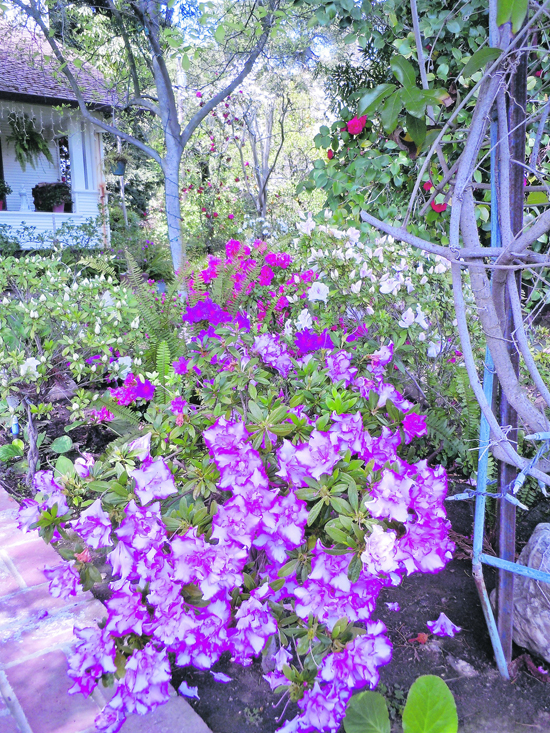 | | Azaleas in many colors with red camellia trees highlight
this serene shade garden. Photos Cynthia Brian
| "As is the garden such is the gardener." Francis Bacon
During my freshman and sophomore years at UCLA, one of my jobs was managing a popular health food store, Nature's Health Cove, at the time a brand new concept in healthy eating. I vividly remember customers paying as much as ten times the price for small, worm-eaten apples, and limp, shriveled greens that had traveled hundreds of miles to be ingested by wealthy Beverly Hills residents on their new "organic" kick. I'm not sure anyone understood what 'organic' really meant as I repeated my script of "grown without synthetic pesticides, insecticides, fertilizers, colorants, or sewage sludge." Genetically engineered had not yet been invented. But one thing was for sure...these early adopters had climbed onto the bandwagon to nutritious sowing and growing.
It wasn't until the 1960s that agriculture turned into agri-business with large corporations buying farms and science genetically modifying the seeds we plant. Before that time, farmers saved, exchanged, traded, and sold seeds that had been in their families for generations. (I still plant, harvest, save, gift, and sell heirloom Hollyhock seeds that are over 100 years old brought over on "the boat" by my grandparents from Italy.) Varieties that have been cultivated and passed down through the ages via human and natural selection are termed "heirlooms." Most people believe that tomatoes are the only heirlooms when actually there are thousands of varieties of produce that are heirlooms including beets, cauliflower, squash, melons, beans, eggplants, peppers, lettuces, and flower specimens. (You've heard of heirloom roses, right?)
As a gardener, if you want to save seed from year to year, you need a glossary of understandable terms. To help you sow and grow, I have created a simple guide help you make informed decisions for buying, planting, and consuming.
Organic: "Certified organic" is a legal term that may be used only by growers who are in strict compliance with all the detailed rules and regulations of the USDA's National Organic Program. In the United States, this means that the soil in which the crops are grown must not have had any prohibited substances in it for the three years prior to harvest. The operation must be managed according to an approved Organic System Plan and the parcel must be inspected by a USDA accredited certifier. The words I used in my college script to describe the meaning of "organic" while working at the health food store are still true today for anything deemed to be organic with the addition of "not genetically engineered."
GMO: Genetically modified organisms are any plants produced through genetic modification either by engineering or long time plant breeding methods that could happen naturally. Even an organically grown plant that has been manipulated to improve production, quality, color, or performance, may be considered genetically modified because these changes could occur in nature. A great example of a popular GMO is the seedless watermelon.
GE: Although the terms GE and GMO are frequently used interchangeably in the media, their meanings are very different. GE refers to genetic engineering using high-tech methods that change the DNA of the plant in a way that would never occur without human intervention. GE plants are not found growing naturally. Big agri-business farms use corn, cotton, soybeans, and other crops that have been genetically engineered. The issues of GE food sources are controversial as the benefits or harm to our health have not been accurately quantified.
Cultivar: This is a variety of a plant that has been selected through cultivation. It maintains its characteristics through propagation. A cultivar can be either a hybrid or open-pollinated variety. In catalogs, when you see the genus and species listed with a Latin name and a common name, the cultivar is usually the common name. For example, Alstroemeria's common name is Peruvian Lily.
Open-Pollinated: An open-pollinated plant breeds true from seed from the parent plant with the offspring having the exact characteristics. By allowing the natural flow of pollen between the same variety of different plants production happens. If your desire is to save pure seed, plant only one variety to prevent cross-pollination between different varieties.
Hybrids: Like a car that uses both gas and electricity, when you cross different varieties of plants, you get a hybrid. Because of population density, it is more difficult than ever to grow a garden with seed purity. Wind, insects, neighbors, dogs all contribute to occasional contamination. If you want heirlooms, buy seeds from a reputable source and grow them in a greenhouse.
Heirlooms: Generally defined, heirlooms are the result of natural selection in open-pollinated varieties. Depending on the source, an arbitrary age marker for an heirloom is fifty years or developed prior to the 1950s. Before the population explosion, heirlooms did pass down from family to family, farmer to farmer. Today, the majority of heirloom seeds and plants are propagated by commercial companies who are dedicated to the preservation of plant purity.
Personally, I am nervous about GE experimentation. My land is a sacred temple for my family and it's my responsibility to protect and nurture it. A non-profit organization, The Council for Responsible Genetics, has a mission to educate the general public about advocating for socially responsible use of new genetic technologies. Growers who wish to not indulge in GE sowing sign a Safe Seed Pledge to not buy or sell genetically engineered seeds.
With all the seed choices in the marketplace, it behooves every gardener to take a few minutes to understand the terminology of modern growing practices. If we are what we eat, we definitely want to make sure that we cultivate the healthiest choices for our human homes. Know, sow, grow!
|
ASK CYNTHIA:
Reader Requests
"Your column inspires me. Where would I find those beautiful varieties of daffodils featured in Digging Deep early this year?" Allison M
Check for rare varieties at your favorite local nursery or garden center. If you can't find something you like, I have recommendations for companies from whom I purchase special species. Read the catalogues carefully as bulbs go by different names. Look at the photos and read the descriptions to purchase plants suitable to your micro-climate that will be beautiful, long flowering, and fun.
Here are a three of my favorite resources:
- Antique Flower Bulbs for Every Garden:
http://www.oldhousegardens.com
- Other bulbs:
http://www.johnscheepers.com
http://parkseed.com/bulbs/c/bulbs/
If you have a garden question, email
Cynthia@GoddessGardener.com and I'll print as many answers as time and space allow. I regret I can't personally answer individual concerns.
|
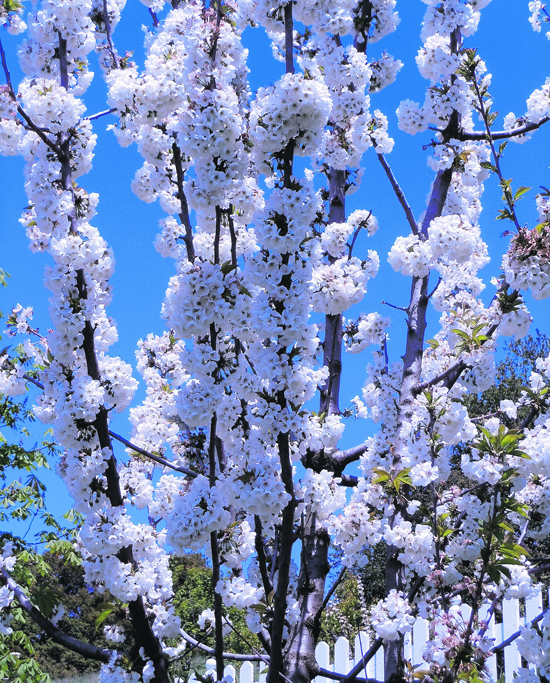 | | The cotton ball puffs of the Queen Anne - cheery bode for a bountiful crop.
| 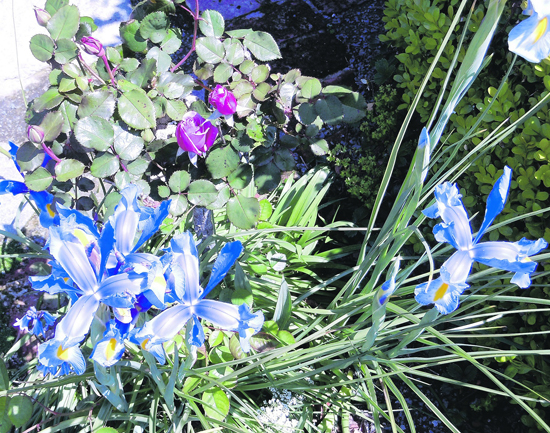 | | Blue and yellow Dutch iris sprout up beneath the first buds of Angel Face roses.
| 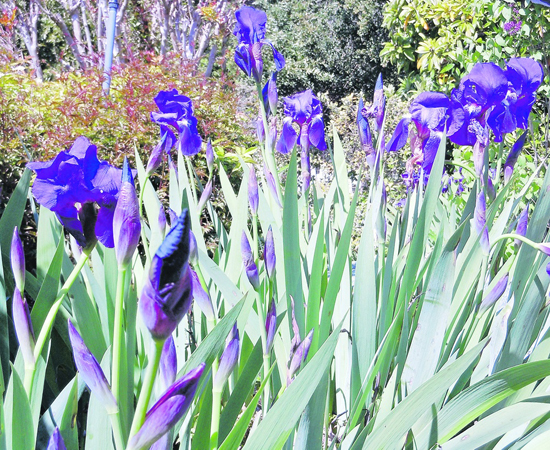 | | Bearded iris in velvety royal purple can be divided and shared after blooming.
| 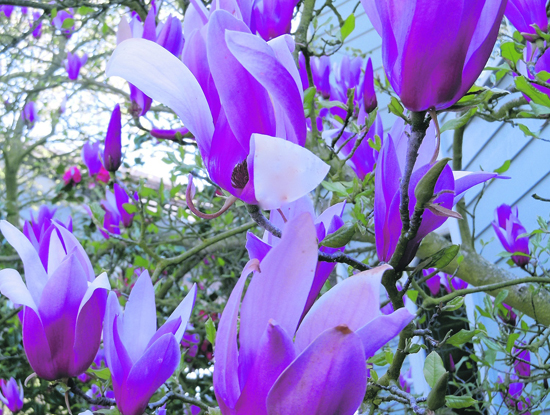 | | Tulip magnolia - one of the most elegant of flowering small trees.
| |
Cynthia Brian's Gardening Guide for May
"In every walk with nature, one receives far more than he seeks." John Muir
April showers did indeed bring May flowers. Our lush landscapes are blanketed with blooming bushes, trees, bulbs, annuals, and perennials. Blossoming black currants, wood hyacinths, forget-me-nots, bearded iris, tulip magnolias, azaleas, roses, osteospernum, and alpine strawberries are the panoramic backdrop for nature's artisanal display. A walk in the woods is a "must do" activity this time of year when wild flowers furnish a rainbow-colored kaleidoscope, creeks are filled with frogs croaking their alluring mating calls, and wild turkeys double gobble on their hillside sortie. Inhale the fragrance of the cherry and crabapple blossoms, forage for watercress, and delight your family with sweet anise licorice-flavored fennel snips in your next salad. With Mother's Day around the corner, it's time to prepare our plots and get our summer gardens readied. Grab your gloves, hat, and trowel, get out into the sunshine, and start digging deep!
- THINK bulk when buying compost. Twenty-seven bags of compost equal one cubic yard covering 192 square feet (10' x 16').
More information at www.compostingcouncil.org.
- PLANT beans, squash, cucumbers, corn, gourds, melons, and pumpkins directly into the garden now. Because of their tender taproots, they do not transplant well.
- PACK in the pretty with boughs of cherry blossoms arranged in a wide mouthed vase. This year of 2012 is the 100th Anniversary of the Cherry
Blossom Festival in Washington, D. C. commemorating the 3,000 cherry trees given to our nation's capital by the people of Tokyo.
- PROTECT your seedlings from the hungry birds by netting your newly planted area. If you wish to protect individual plants, use upside down
berry crates until fully leafed.
- DINE alfresco on Mother's Day with a picnic on your lawn. Spring flowering beds lend a painter's palette of color.
- PLAN your potager for practicality, production, and pretty.
- GRAVEL paths as an inexpensive and attractive way to dress up a walkway.
- PINCH the tips of fall bloomers such as asters and mums for a bushier performance.
- DIVIDE and transplant overgrown fall blooming perennials.
- STAKE tall flowers such as digitalis to prevent toppling.
- DEADHEAD spent blooms on calendula, pansy, cyclamen, and calla lily to encourage more blooming.
- ATTRACT the ladybugs, bees, and other beneficial insects with plantings of lavender, rosemary, cosmos, salvia, sunflowers, sedum, and butterfly bush.
- WELCOME wildlife to your backyard by providing food, shelter, water, and nesting opportunities. Turn your area into a wildlife habitat.
- CLEAN greener this spring by using friendlier ingredients found in your garden such as lemon juice to remove grease, mildew, and stains.
- VISIT the Be the Star You Are! and Express Yourself! Teen Radio booth at the Moraga Faire to pick up a FREE bag of home-grown potpourri and heirloom
Hollyhock seeds. I'll be there to answer your gardening questions and encourage you to be interviewed LIVE on our international award-winning radio program.
- USE biodegradable 100% coconut husk fiber pots planted directly in the ground in place of plastic. They are a renewable resource and promote rapid, robust root growth.
- EDUCATE yourself about the origin of your favorite blooms. Did you know that tulips were wildflowers that originated in the 1500s in Persia?
- BUY fresh organic, free-range eggs packed with Vitamin D, iron, folic acid, high quality protein, and only 70 calories a pop. Studies indicate that people
who eat at least one egg a day have LOWER rates of heart attack and stroke. Aged chicken manure is the best fertilizer for your garden.
- BREATHE easier indoors by filling your home and office with toxin-eating houseplants such as philodendron, peace lily, or spider plants. One potted
plant per 100 square feet of space will clean the air of common indoor chemicals like formaldehyde, benzene, and trichloroethelyne.
- ALLOW your daffodils, Dutch iris, and tulips to wilt naturally, giving the bulbs the extra nutrients they need for next season's spectacle.
- WALK a nature trail for exercise, beauty, and curiosity satisfaction.
- PAMPER the Mother in your life with a fragrant freesia posie bouquet plucked from your vernal flowerings.
Let your creativity blossom this spring while you indulge in strolling in secret gardens and sampling exotic specimens. It's May, the season of play.
Happy Gardening to You!
(c)2012
Cynthia Brian
The Goddess Gardener
Cynthia@GoddessGardener.com
www.GoddessGardener.com
925-377-7827
I am available as a speaker, designer, and consultant.
| | | | Advertisement
| | |
| | | print story
Before you print this article, please remember that it will remain in our archive for you to visit anytime.
download pdf
(use the pdf document for best printing results!) | | | Comments | | |
| | | | | | | | | | | | | | | | |






